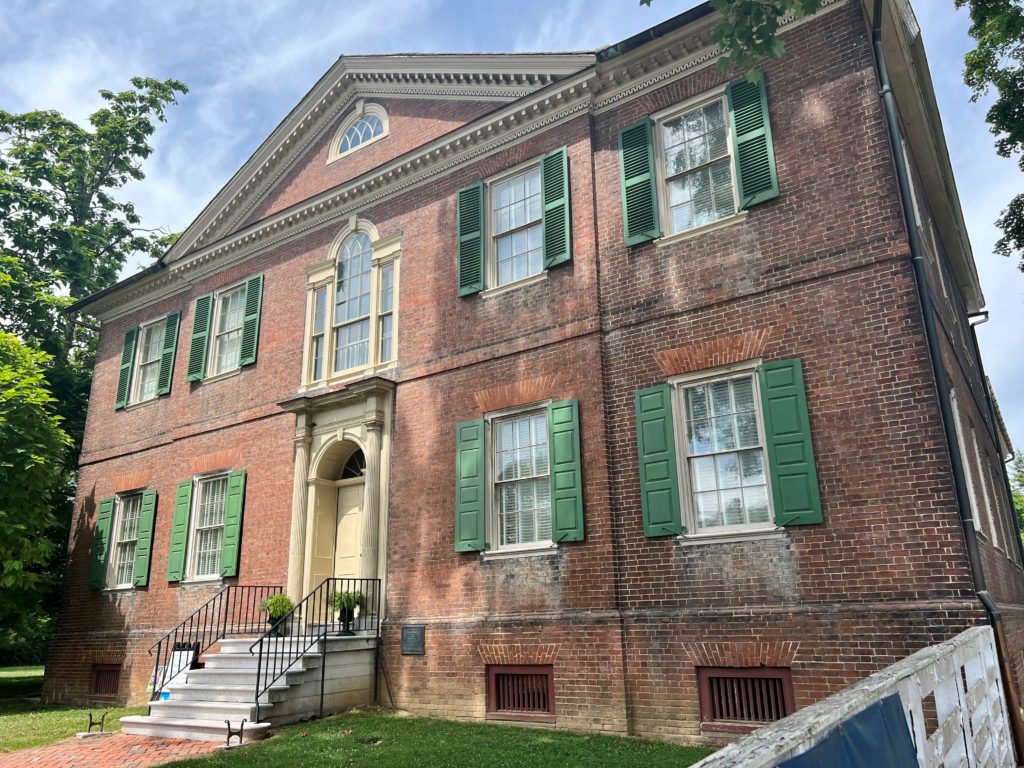The two-story red brick building at 202-218 Wilkinson Street may look like any other Federal-style dwelling in Frankfort’s historic district.
But if ever there was a case of “if these walls could talk, what a story they would tell” – a story of both a newly minted Kentucky and a fledgling America in the latter part of the 18th century.
It’s not an overstatement that Liberty Hall, dating back to 1796, played a significant role in Colonial history.
John Brown, a Virginian and the original owner of the house, represented that state in the Continental Congress of 1777-78 and the U.S. Congress from 1789-1791. It’s important to note that he was representing his home state of Virginia – in which Kentucky was a slice of western frontier far removed from the seat of government in the Tidewater Region.
Brown saw the problem of trying to govern such a remote area and spent his time lobbying for a separate state. In 1792, he saw his labors for introducing a bill that would make Kentucky the 15th state come to fruition.
He was further rewarded by becoming the new state’s first U.S. Senator, and even served a term as president pro tempore of the Senate (1803-04).
An educated and cultured man, Brown was friends with many of the great men of the day. He served under George Washington during the Revolutionary War, was a roommate of Thomas Jefferson when both studied law in Virginia, and was a great friend of the Marquis de Lafayette.
As the story goes, the Marquis was so close to Brown and his wife Margaretta that he made what might have been considered a social faux pas.
On his farewell tour of America before returning to France, he was feted at the Old State Capitol. Upon finding that Margaretta, still grieving the death of a child, was not in attendance, he left his own party to pay her a visit at Liberty Hall, ringing the same doorbell that today’s visitors ring for entry.
Another memorable morning occurred in 1819 when Brown played host to a past president, James Madison; the current president, James Monroe, and two future presidents, Andrew Jackson and Zachary Taylor.
The men were on a tour of the southern states and had been invited to breakfast in the Liberty Hall dining room, using the same fine china and crystal still on display today. Unlike many historic homes which use reproductions, Liberty Hall’s collection of original furniture, dishes, clothing and art (including a portrait of Brown by Matthew Jouett which hangs in the parlor) is intact. Intact down to the receipt from the shop in New Orleans where the Browns purchased the china for the dining room.
As impressive as the house is, the five acres of grounds are equally so. In Brown’s day, the formal gardens which sloped down to the river boasted cuttings brought from Mount Vernon, and an orchard planted with blackberries, raspberries, cherries, currants and grapes.
The latter had a particular place in the commonwealth’s history, as another of Brown’s accomplishments was supplying the grapes for First Vineyards in Jessamine County. In 1799, it became not just the commonwealth’s first commercial winery, but the first in the United States.
The vineyards are gone now, as are the seed bed, chicken yard, slave quarters and bowling green. However, the original smokehouse remains, as do the bricks surrounded by fragrant boxwoods. The three gnarly and twisted catalpa trees in the garden have a history of their own.
Upon completion of their house in 1800, John and Margaretta planted the first of the trees. A second was planted in 1900 and a third in 2000 – both by descendants of John and Margaretta.
The tradition of having a Brown descendant plant a tree every 100 years is one that Liberty Hall’s executive director Jessica Stavros hopes will continue.
Upon Brown’s death in 1837, his beloved home went go to his elder son Mason, but he didn’t leave his younger son Orlando homeless. He commissioned architect Gideon Shryock, who designed both the Old State Capitol and Transylvania University in Lexington, to build a house on the opposite side of the garden for Orlando.
Today, the Greek Revival-style house is part of the Liberty Hall National Historic Site.
Mason seems to be shrouded in the mists of history, and though not as politically influential as his father, Orlando, nevertheless had his own achievements.
While his father chose law, Orlando opted for a writing career – perhaps encouraged by his friend, novelist Washington Irving. Eschewing fiction, Orlando co-founded the Commonwealth, a Frankfort newspaper sympathetic to the Whigs.
Orlando did find time for politics, serving as Kentucky’s Secretary of State under Governor John J. Crittenden, and as Commissioner of Indian Affairs under President Zachary Taylor.
If his father played a key role in the efforts to create a free Union, his son played a role in the efforts to preserve it. Although a slaveholder, he favored preserving the Union, and made this the editorial focus of his newspaper.
Today, that red brick building on Wilkinson Street has a history that can compare with any historic house in America. And its owner John Brown, a leader in politics, business, society and community is frequently referred to as “the Father of Kentucky.”
Part 2 of the Liberty Hall story will focus on the efforts being made to keep the house relevant for today’s visitors.

